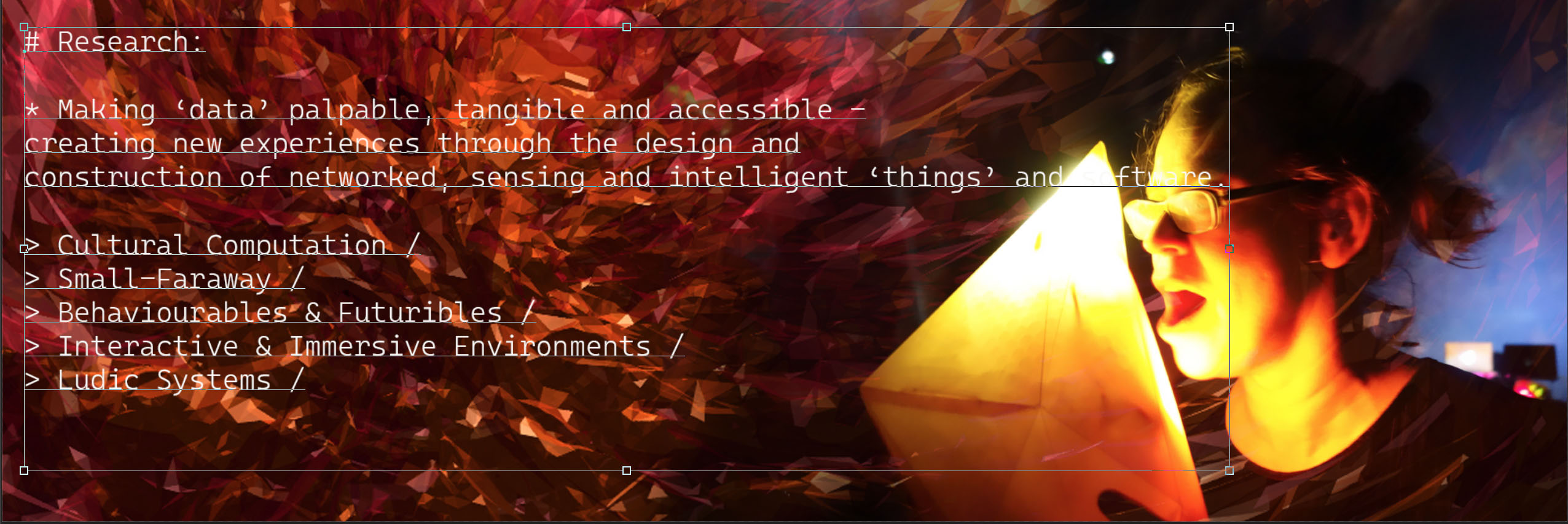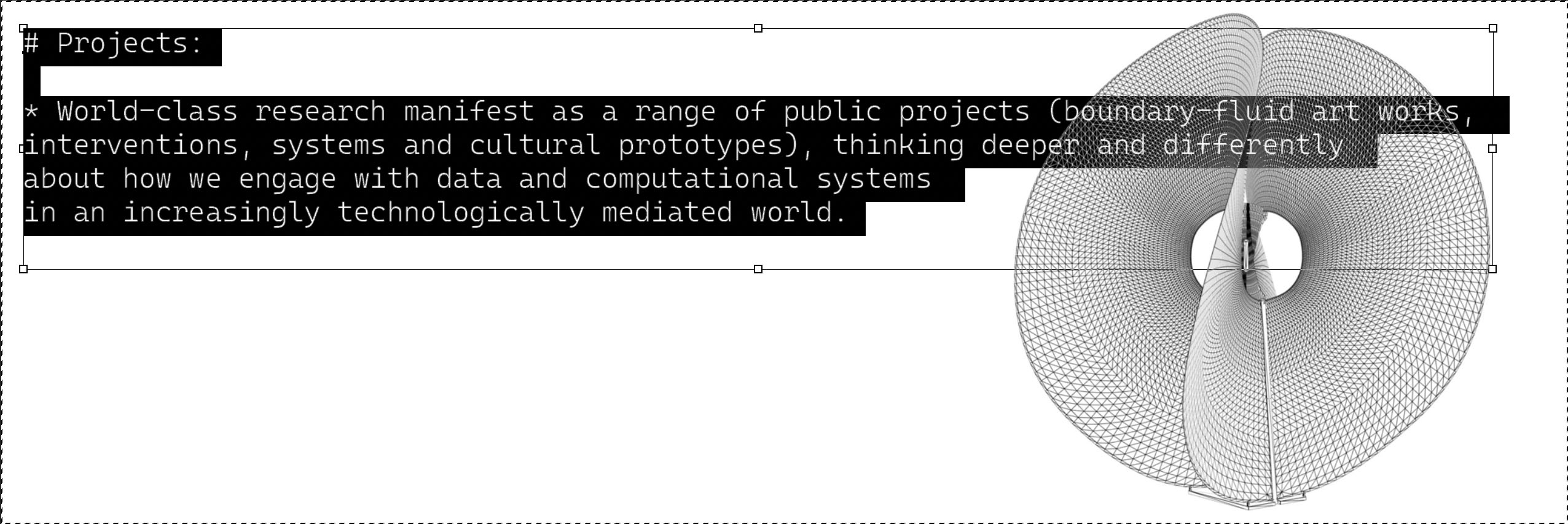Roy Ascott /
When art is a form of behaviour, software predominates over hardware in the creative sphere. Process replaces product in importance, just as system supersedes structure. Consider the art object in its total process: a behaviourable in its history, a futurible in its structure, a trigger in its effect.
Roy Ascott 1968

This exhibition is rooted in the artistic practice and concepts of University of Plymouth Professor, British artist and ‘visionary pioneer of media art’, Roy Ascott that include cybernetics (systems based art), telematics (the art of telecommunications and informatics) and technoetics (the technology of consciousness.). FUTURE HISTORY maps this influence on emerging contemporary art forms, including digital, wearable, immersive, biological and artificial.
Works on show in FUTURE HISTORY v1.0:
Groundcourse Calibrators /
Roy Ascott /
1963 /

The Groundcourse was a creative leaning strategy developed by Ascott at Ealing Art College in London from 1961 to 1964 and at Ipswich Civic College in Suffolk from 1964 to 1967.
“For centuries we have been dominated by the fixed viewpoint, which says that I am the boss of what I see, I create the world. In this viewpoint the human being is the centre of everything and the way you understand the human being is not through their minds, it‘s through their bodies. And not the energy of the body, but the taxonomy of the body. And so, we had anatomy as the core discipline for art schools which has always seemed absurd to me”. (Ascott 2010).
“The mindmap shows how this entity relates to the world: Is there a God that controls it all? Is there an inner self that controls it all? Is it the environment? So, you could model this any way up that you liked and they were shown various ways in which it can be done, that there are these differences. And after that you build the calibrator, which was a little gizmo, usually made out of paper but sometimes also out of wood or even combinations of materials. Nowadays it would be programmed on a computer, of course. Into this device you fed the input, for example something like ‗if in a large room with only two or three other people,‘ then the outcome is that you cannot use rope, or your left leg – which were the physical limitations that would keep changing depending upon the change in input as you moved through the environment. That was 86 the whole point, that you had to be hyper-observant to the environmental changes, depending on which you had to re-calibrate the gizmo that would tell you what the new limitations were which the changes around you had brought about. Whatever the playout was in terms of behavior, attitude or materials, those were the conditions which you had to take into account as you went about your work. In the end, it was about being absolutely vigilant, to induce a kind of awareness to your environment at all times, one which would also extend beyond the studio. (Ascott 2010)
Blackboard Notes /
Roy Ascott /
1964 /

Behaviourables and Futuribles /
Roy Ascott /
1968 /
Roy Ascott 1968
When art is a form of behaviour,. software predominates over hardware in the creative sphere. Process replaces product in importance, just as system supersedes structure.
Consider the art object in its total process: a behaviourable in its history, a futurible in its structure, a trigger in its effect.
…
Plastic Transactions /
Roy Ascott /
1970 /

Silent 700 /
Texas Instruments [Roy Ascott] /
1971 /

The Silent 700 (1971) was a portable computer terminal made by Texas Instruments. The dot matrix printer and acoustic coupler for a standard phone for networking through telecom phone lines. Ascott used this instrument to deliver a range of networking projects into the 1980’s.
https://en.wikipedia.org/wiki/Silent_700
La Plissure du Texte /
Roy Ascott /
1983 /

In early 1983, Roy Ascott was invited to propose a work for the exhibition “ELECTRA 1983” – a survey of the use of electricity in art – organised by Frank Popper for the Musée d’Art Moderne de la Ville Paris. Ascott’s proposal was to use the ARTEX network both as an organising instrument and as a textual medium for the creation of a world-wide, distributed narrative – a collective global fairy tale.
On July 13 he posted a description of the project and call for participation on ARTEX and artists and groups in 11 cities in Europe, North America and Australia agreed to join the project. In November each participant was allocated the role of traditional fairy tale character: princess, witch, fairy godmother, prince etc.. (see message below)
Beyond the simple idea of a fairy tale, Ascott did not suggest a story line or plot – the artists were simply asked to improvise. The result was that, due to the differences between time zones and the nature of improvisation, the narrative often overlapped and fragmented in the manner of the surrealist game of “Exquisite Corpse”.
From: http://alien.mur.at/rax/ARTEX/PLISSURE/plissure.html
“Telematic culture means, in short, that we do not think, see, or feel in isolation. Creativity is shared, authorship is distributed, but not in a way that denies the individual her authenticity or power of self creation, as rather crude models of collectivity might have done in the past. On the contrary, telematic culture amplifies the individual’s capacity for creative thought and action, for more vivid and intense experience, for more informed perception, by enabling her to participate in the production of global vision through networked interaction with other minds, other sensibilities, other sensing and thinking systems across the planet—thought circulating in the medium of data through a multiplicity of different cultural, geographical, social, and personal layers. Networking supports endless redescription and recontextualization such that no language or visual code is final and no reality is ultimate. In the telematic culture, pluralism and relativism shape the configurations of ideas —of image, music, and text—that circulate in the system.
It is the computer that is at the heart of this circulation system, and, like the heart, it works best when it becomes invisible. At present, the computer as a physical, material presence is too much with us; it dominates our inventory of tools, instruments, appliances, and apparatus as the ultimate machine. In our artistic and educational environments it is all too solidly there, a computational block to poetry and imagination. It is not transparent, nor is it yet fully understood as pure system, a universal transformative matrix. The computer is not primarily a thing, an object, but a set of behaviours, a system, actually a system of systems. Data constitute its lingua franca. It is the agent of the datafield, the constructor of dataspace. Where it is seen simply as a screen presenting the pages of an illuminated book, or as an internally lit painting, it is of no artistic value. Where its considerable speed of processing is used simply to simulate filmic or photographic representations, it becomes the agent of passive voyeurism. Where access to its transformative power is constrained by a typewriter keyboard, the user is forced into the posture of a clerk. The electronic pa palette, the light pen, and even the mouse, bind us to past practices. The power of the computer’s presence, particularly the power of the interface to shape language and thought, cannot be overestimated. It may not be an exaggeration to say that the “content” of telematic art will depend in large measure on the nature of the interface; that is, the kind of configurations and assemblies of image, sound, and text, the kind of restructuring and articulation of environment that telematic interactivity might yield, will be determined by the freedoms and fluidity available at the interface.
The essence of the interface is its potential flexibility; it can accept and deliver images both fixed and in movement, sounds constructed, synthesised, or sampled, texts written and spoken. It can be heat sensitive, body responsive, environmentally aware. It can respond to the tapping of feet, the dancer’s arabesque, the direction of a viewer’s gaze. It not only articulates a physical environment with movement, sound, or light; it is an environment, an arena of dataspace in which a distributed art of the human/computer symbiosis can be acted out, the issue of its cybernetic content. Each individual computer interface is an aspect of a telematic unity such that to be in or at any one interface is to be in the virtual presence of all the other interfaces throughout the network of which it is a part. This might be defined as the “holomatic” principle in networking. It is so because all the data flowing through any access node of the network are equally and at the same time held in the memory of that network: they can be accessed, through cable or satellite links, from any part of the planet at any time of day or night, by users of the network (who, in order to communicate with each other, do not need to be in the same place at the same time).”
extract from: Is There Love in the Telematic Embrace? Roy Ascott 1990
Aspects of Gaia /
Roy Ascott /
1989 /

Bio:
Ascott exhibits internationally (including the Biennales of Venice and Shanghai), and is collected by Tate Britain and Arts Council England. He is recognised by Ars Electronica as the “visionary pioneer of media art”, and widely seen as a radical innovator in arts education and research, having occupied leading academic roles in England, Europe, North America, and China, and is currently leading his Technoetic Arts studio in Shanghai, and directing the Planetary Collegium [https://en.wikipedia.org/wiki/Roy_Ascott]




You must be logged in to post a comment.